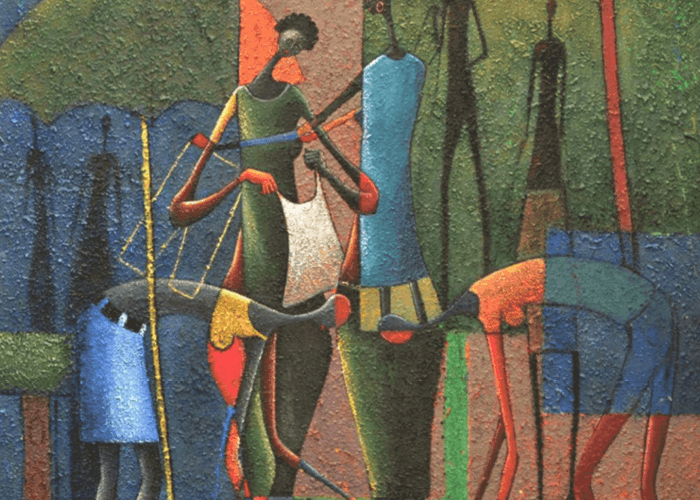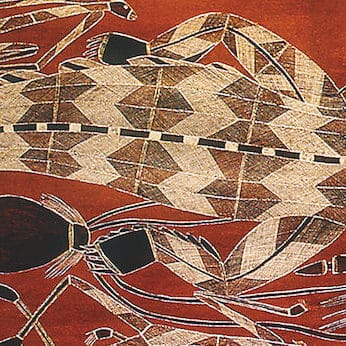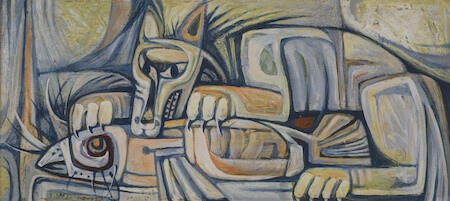 FROM THE SAMMY OLAGBAJU COLLECTION: Sokenu Abayomi, Bend Down Select, 2012. Acrylic on canvas, 122 x 122cm (DETAIL) – Featured on the cover of the inaugural issue of the AACR.
FROM THE SAMMY OLAGBAJU COLLECTION: Sokenu Abayomi, Bend Down Select, 2012. Acrylic on canvas, 122 x 122cm (DETAIL) – Featured on the cover of the inaugural issue of the AACR.ART AFRICA is excited to announce the launch of the ART AFRICA COLLECTORS REPORT (AACR), in partnership with Auriti – Fine Art Collection, Advisory and Exhibition Specialists. Drawing on their research and consulting expertise, this publication will have a dedicated emphasis on contemporary and modern art from Africa, featuring in-depth analyses of trends in collecting and the art world at large.
Focusing on art investment, auctions, collectors and collecting, the ART AFRICA COLLECTORS REPORT makes use of both independent research and findings and existing research data. Our internal team of AACR researchers and analysts work daily to compile data in order to identify trends and opportunities within the growing contemporary African art market. With several decades of experience, our board of experts has built extensive databases and maintains valuable relationships with decision makers and industry specialists around the world.
As the traditional markets continue to face tough challenges, high-net-worth individuals (HNWI) seek new havens for investment. The art investment industry and auction markets continue to grow as an alternative market, attracting both established and new wealth.
While there is a strong global focus on the emerging markets of the Middle East, China, and more recently Latin America, AACR focuses its lens on the African continent, highlighting the maturity of the various regions and offering a platform that brings together all the activities in one go-to resource.
Additionally, by looking at private and corporate collections, AACR investigates the African contemporary and modern art scenes, presenting insights and collection particulars – with a country and regional focus – in order to map the geography of collectors both on the continent and further afield. As our emerging collectors base grows, the AACR will curate, collate and deliver the most up-to-date analyses and statistics exclusively for our network of collectors and art world stakeholders.
Our data findings will be supplemented with personal, in-depth interviews with established and emerging collectors, art world specialists and decision makers, curators and financial experts – all in an effort to keep our audience up-to-date and in the know.
Specific areas of focus include art fairs that maintain a view to contemporary and modern art from Africa and the diaspora, auction market news and results, high- performing artists in the market place and emerging artists to watch. We explore and pay close attention to the emergence of private museums and institutions that are taking on the role and place of their public counterparts. Examples of these are the Museum of African Design (MOAD), the Zeitz MOCAA (both South Africa), Fondation Zinsou (Benin) and the RAW Material Company (Senegal) among many others.
We trust that this first mini-issue will give you some insights into what you can expect from the AACR, which will be published as a limited edition sister publication to the 2015 December Issue of ART AFRICA magazine.
– BRENDON BELL-ROBERTS
Art Fairs. Where Does the Value Lie?
The difference between a fair and a gallery lies in the nature of the relationship between the dealer and the collector. The nature of the interaction is decidedly unique and both collector and dealer approach visiting fairs and galleries in different ways. It is important to understand the dealers’ intention at an art fair; not simply to sell art, but often to sell the gallery.
A fine art dealership has two identifiable commodities — its artists (artworks) and its opinion — the latter being monetised from time to time in the guise of publications and advisory activities. A seasoned, well- respected dealer correctly contributes to pushing art forward for the sake of art through informed opinion, a good eye, and an ability to convince people of the strength of one artist versus another.
The most important commodity however is the artist him/herself. An art dealership is not much more than a decor shop without stable artists. You can measure the success of a gallery by the calibre and reputation of the artists it represents. A dealer friend once quipped, “the coolest dealers in the world represent the coolest artists in the world”.
So how does a gallery go about attracting the best, newest, freshest artists to its camp? Many factors play a part, but the two most recognised ‘wants’ of an artist are the volume of sales and amount of international exposure. To quote a gifted artist, “I need to eat, and someone in Berlin needs to know who I am”.
Galleries mostly seek out collectors in their immediate geographic reach to keep artworks leaving the front door. A few global galleries — White Cube, Gagosian, Opera, and a few others — have branches in multiple cities and their stable of artists have a global presence. For the rest…art fairs, art fairs, and more art fairs. Artists demand it. Not only is the gallery trying to sell art, but often an ulterior motive of presenting is to peacock the gallery to other artists. The dealer has to show non-stable artists what a great job the gallery is doing for its own artists, with healthy prices, to assure potential converts that their careers will be safe if they cross over.
This phenomena not only applies to high end fine art galleries, but it also effects the Blue Chip Global players. This psychology causes price volatility at a fair. Often the price starts higher than if you bought it off the wall at the gallery, and slowly corrects during the fair. Dealers won’t adjust the price list, but will gain a lot of flex during price negotiation.
If visiting a fair with the intent of buying, here are a few recommendations. Firstly, stay the weekend. Fairs always fall over a weekend, and the ones worth visiting are in fabulous cities. Stay until Sunday, and if you can help it, only buy on Sunday. Of course if there is something coveted, and resistance is futile, go ahead but negotiate on the price. Many factors influence a dealer when pricing works for the fair (recently, foreign exchange rates have made South American and African purchases very favourable), and thus builds in some margin into the retail price to compensate. Also the cost of getting works home if they don’t sell is inevitable, and as the closing bell approaches, pressure to avoid these costs increases. If you buy on a Sunday it is often much easier to negotiate. Even if the fair has been a stellar success for the dealer, they will want to offload works. Moderate interest will lead to a price offer almost all of the time.
Fairs are enjoyable for the obvious reasons; Firstly, you can take in a lot in a relatively short space of time. It is a little like reading the Cheat’s Guide to the Classics, Sense and Sensibility and Moby Dick condensed to twenty-five pages each. Secondly, viewing so many artists in one confined area is very useful in spotting talent and future greatness (conversely, bullshit is easier to spot, mostly because there is so much of it). Lastly, fairs are a good place to buy, if you know how to play the game. If not careful, the price you pay may be influenced by the aforementioned psyche of the dealer, “I must be cool…I must be expensive…I must be cool”.
And don’t miss the opening parties, which are usually raucous and splendid, riddled with artists, dealers and of course buyers. With considered research, assurance and understanding of the tactical game that is an art fair, a buyer can walk away with a loved thing bought at a favourable price.
– AURITI FINE ART ADVISORY
Auriti is a fine art advisory based in Cape Town, Johannesburg, and London. Coming from a background in global art markets they specialise in collection management, acquisitions, deaccessions, curatorial, and project expertise; customised for individual, institutional, or corporate needs.



